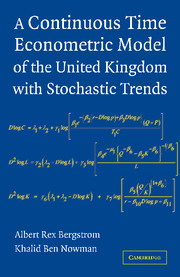Book contents
- Frontmatter
- Contents
- List of Figures and Tables
- Foreword by Peter C. B. Phillips
- Preface
- 1 Introduction to Continuous Time Modelling
- 2 Continuous Time Econometrics with Stochastic Trends
- 3 Model Specification
- 4 Steady State and Stability Analysis
- 5 Empirical Estimation of the Model and Derived Results
- References
- Author Index
- Subject Index
Foreword by Peter C. B. Phillips
Published online by Cambridge University Press: 03 March 2010
- Frontmatter
- Contents
- List of Figures and Tables
- Foreword by Peter C. B. Phillips
- Preface
- 1 Introduction to Continuous Time Modelling
- 2 Continuous Time Econometrics with Stochastic Trends
- 3 Model Specification
- 4 Steady State and Stability Analysis
- 5 Empirical Estimation of the Model and Derived Results
- References
- Author Index
- Subject Index
Summary
The daunting complexity of aggregate economic behaviour has led recent generations of macroeconomists to pursue a rich diversity of approaches in modelling. Some have focused on the development of tightly specified small scale systems that embody rational expectations, real business cycle mechanisms and intertemporal optimization principles to strengthen the economic foundations of the models and furnish meaningful prior restrictions. Others have preferred the use of model formulations that are more convenient in coping with the time series properties of the observed series, using both parametric and semiparametric approaches, and allowing for mechanisms that can accommodate the regime changes that can occur in practice. Still others have begun to work with large dimensional panels and dynamic factor decompositions.
One unifying force amongst the growing diversity of empirical modelling research in macroeconomics has been acknowledgement of the importance of long-run behaviour and the recognition that trending mechanisms in economics are stochastic. A second area of commonality lies in the use of nonlinear dynamics, both systems dynamics and volatility dynamics, the latter being especially important in financial market applications.
The present volume reports the construction and implementation of a new macroeconomic model of the UK economy that embodies most of these themes. While the model differs from much of the mainstream of modern macroeconomics in terms of its genesis and form, it shares some commonality with mainstream work in its detailed attention to nonlinear dynamics, its concern for stochastically trending data and its use of dynamic optimization principles in the derivation of adjustment relations.
- Type
- Chapter
- Information
- Publisher: Cambridge University PressPrint publication year: 2007



